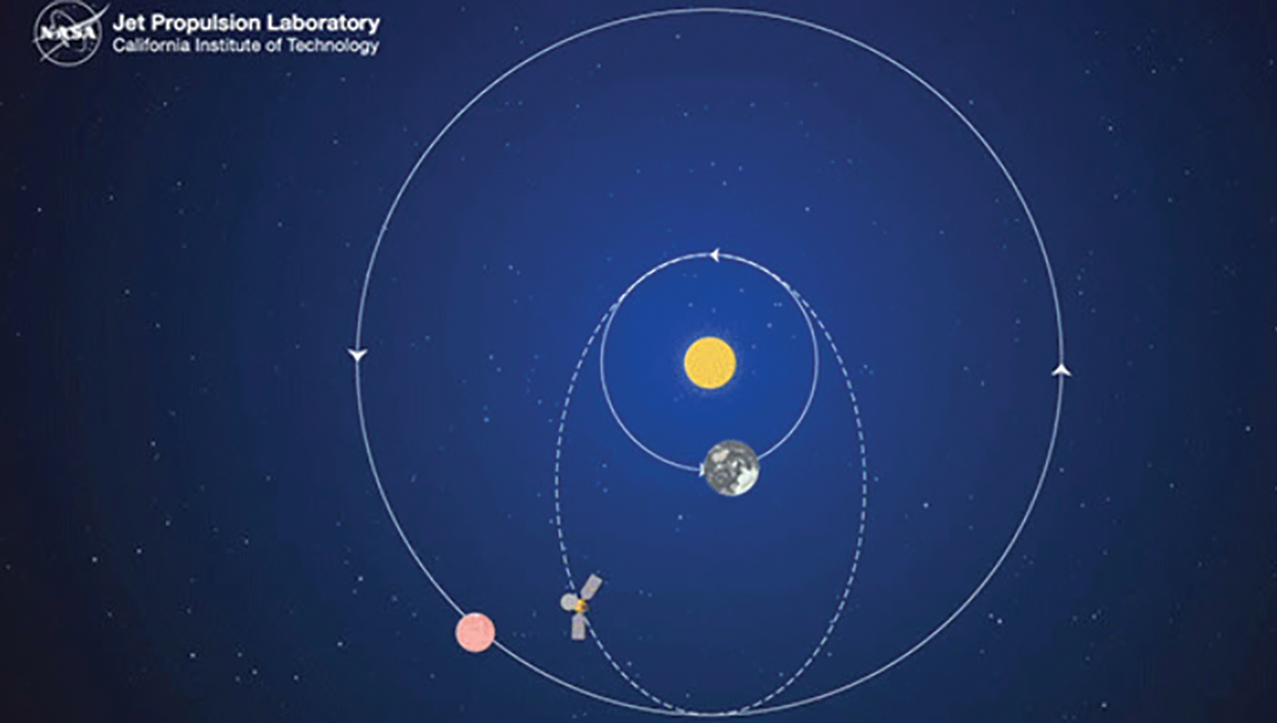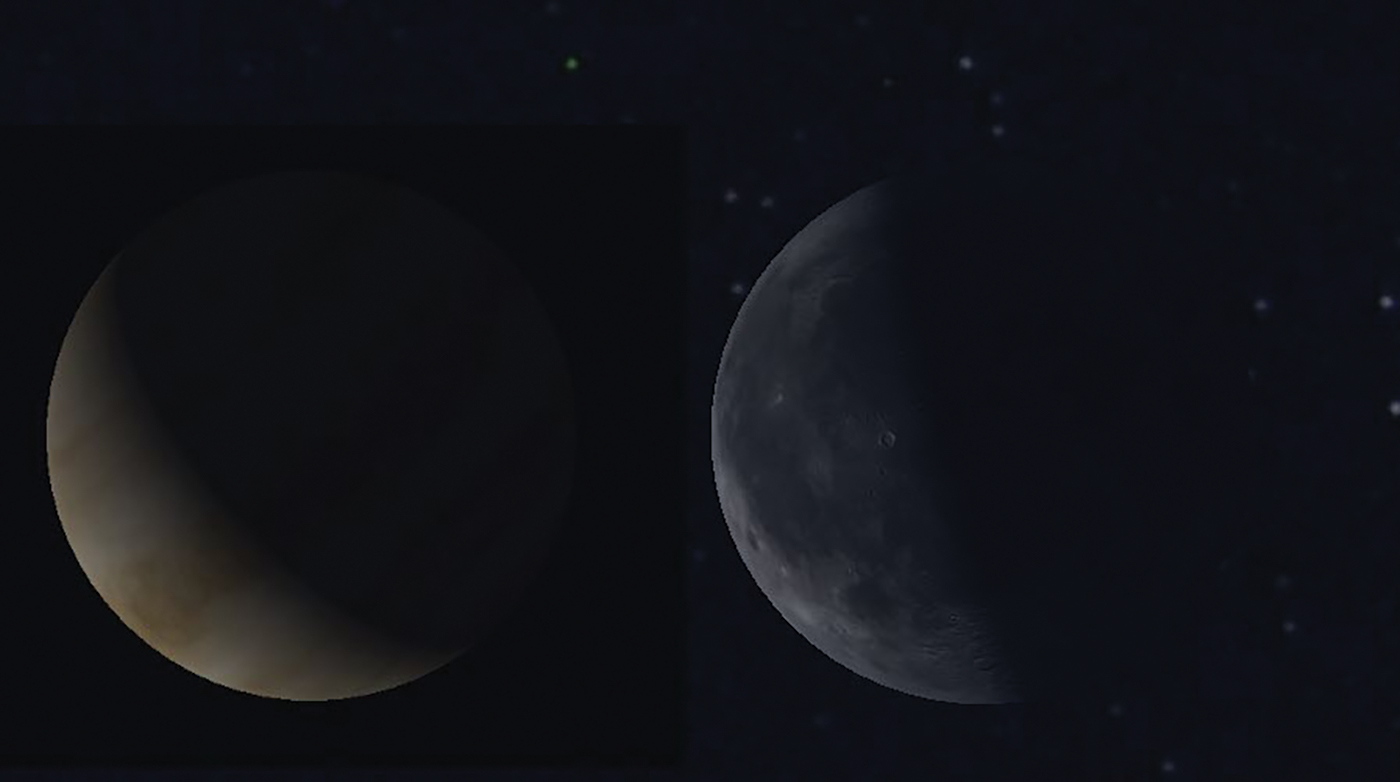Scope on the Skies
Back to Mars
Science Scope—July/August 2020 (Volume 43, Issue 9)
By Bob Riddle
This month the “launch window” opens for a mission to Mars. This is the span of time approximately every 26 months when the Earth and Mars are in orbital positions around the Sun that allow for a trip to Mars to last around 7 to 9 months. Because Earth is orbiting faster than Mars, spacecraft launched to Mars already have the Earth’s velocity built in. So, taking advantage of that plus the spacecraft’s own acceleration and precise mathematical calculations, a Mars-bound spacecraft will arrive at a position along Mars’ orbit at approximately the same time Mars will arrive there. Spacecraft taking advantage of this current launch window could arrive at Mars orbit during January and February of 2021.
The type of trajectory the spacecraft would follow to Mars is known as the Hohmann Transfer. This orbit allows for missions to Mars that could be a flyby mission, an orbiter, or a landing on the surface for a surface mission. For the same Earth–Mars positioning requirements, any Earth-bound spacecraft from Mars would have to wait 26 months before returning to Earth and would also follow a Hohmann Transfer Orbit (see Figure 1).
The Hohmann Transfer (see Resources) is an elliptically shaped orbital path where at launch the Sun is the focus of the ellipse and the Earth and the spacecraft are at the periapsis (closest to the Sun) of the ellipse. The launch and trajectory to Mars are calculated such that when the spacecraft reaches its furthest distance (apoapsis) from the Sun along its elliptically shaped orbit, Mars will be there. Conversely the launch and trajectory back to Earth would essentially be a mirror of the one to Mars.
Getting to the “Red Planet” is a difficult challenge to achieve, but that is just the beginning, if the launch and the subsequent month’s long cruise phase was successful. Next, depending on the mission, the spacecraft either enters orbit or lands on the surface to begin a lander-based mission, or to deploy a rover. On paper this all sounds rather straight forward; however, out the 56 missions to Mars, only 26 of those were successful in reaching Mars and conducting their respective missions. NASA leads other nations’ space organizations with the number of Mars missions and can claim 23 of the 26 successful missions to Mars. The other three successful missions are from the European Space Agency and India’s ISRO.
Currently there are eight active Mars missions: two surface missions, NASA’s Insight Lander and the still operating Opportunity Rover, and six Mars orbiter-based missions operated by NASA, ESA, and ISRO, India’s space program.
Three to go
There are three planned missions to Mars this summer starting in July when the launch window opens. NASA, and two other space organizations, United Arab Emirates Mars Mission (EMM) and the China National Space Administration (CNSA), are set to take advantage of the Earth–Mars orbit positions. By the start of the 2020–2021 school year we should know the status of each of the three missions to Mars, especially which ones are successfully on their way to Mars. The coming several months of the school year could open a “learning window” for students to investigate the exploration of Mars and could provide an opportunity for students to work in teams mimicking the Science and Engineering teams working together on a Mars mission. A good starting place could be from the NASA handout, Destination Mars (see Resources). This is a short list of some of the things to be considered when planning a mission to Mars simulation. Although many of the web links are no longer active, this handout does provide useful information for the teacher including objectives, science standards, definitions, and activity suggestions.
NASA Mars rover 2020
The 2020 rover Perseverance (see Resources) carries an entirely new suite of instruments, including a sample-caching system that will collect samples of Mars for return to Earth on subsequent missions. Additionally, this mission includes a small helicopter, the Mars Helicopter Scout. In a similar manner to the first rover remotely controlled on Mars, the Sojourner Rover, this will be a test to see if we are able to fly a vehicle on another world. Following a launch from Florida during July, the Rover should be on the Martian surface at Jezero Crater February 18, 2021.
China’s orbiter and rover
The Chinese space organization plans include an orbiter and a rover, both of which will have a variety of instruments onboard. The orbiter will have two cameras, a spectrometer, and other instruments, while the rover will also carry cameras, as well as instruments for studying the Martian climate and its magnetic environment. The rover will land at one of two locations, one near the Viking 1 lander site and the other landing site further east near the Viking 2 and Opportunity landing sites.
Emirates Mars mission
This first mission to Mars will involve the UAE’s Hope Probe successfully reaching Mars and entering an orbit that will allow instruments onboard the Martian orbiter to conduct an intensive study of the Martian atmosphere. Scientific instruments on the Hope Probe will gather data about the lower and upper regions of the atmosphere as well as study daily weather patterns on a global scale to gain a better understanding of the past climate on Mars.
ESO and Russia’s ExoMars 2022 rover
The European Space Agency’s (ESA’s) mission to Mars originally scheduled for either a July or August 2020 launch has been postponed until the 2022 launch window. The decision was made to better prepare the spacecraft and rover for the mission. When launched, the ESO will successfully land a rover on the surface in an area considered to be a location for finding organic material on the surface or more likely below the surface. A drill will be used to sample materials from as deep as 2 meters. Using a spectrometer among other instruments, the samples will be studied for organics. During the mission lifespan the ESA rover will travel several kilometers from its landing site.
Explore Mars
An engaging way to get students started on their Mars mission would be to show some of the many videos from NASA and others about exploring Mars. Perhaps among the most exciting of the videos about exploring Mars are the videos highlighting the 6 to 10 minutes it takes to enter the Martian atmosphere and reach the surface. The most recent surface mission to Mars was the Insight mission, and its landing video is very well done with explanations about the preparations made for the landing and what is involved with successfully landing on the surface of Mars. Students could view this short 8-minute video and then consider these questions below from the Destination Mars handbook (see Resources).
- What are the orbital challenges of traveling from one planet to another?
- What are the possible paths for a spacecraft traveling from Earth to Mars?
- What could make a spacecraft get to Mars faster?
- What are some of the problems considered by engineers and scientists as they design trips to Mars?
Weather and other data about Mars has been collected over the years from orbiter and surface missions giving us a look into the Martian climate both present and past. Using the resources at the Martian Climate Database Projects website students will be able to explore weather patterns at several of the landing sites on Mars using an online request form. Requests include a variety of filters and altitudes ranging from the surface through the different layers of the atmosphere to choose from. Data is output in a variety of formats including graphs or maps of the area or the entire globe. Additionally, there is a date and time convertor for Earth and Mars and a good explanation of the Martian seasonal year (see Resources).
Students may also explore the surface of Mars with Red Rocks, an online activity at the Infiniscope website. In this activity students explore the red colored rocks in Sedona, Arizona, and the Karijini Gorge in Australia, learn how these rocks show a red color, and then apply this idea to the reddish colored rocks on the surface of Mars.
Another opportunity (pun intended) for exploring Mars is at the NASA Explore Mars: A Mars Rover Game website (see Resources). With this online simulation, students issue sequences of commands to the Mars rover Perseverance for it to move to and explore rocks, and collect data about the Martian surface within its landing area in Jezero Crater. Accompanying the Perseverance rover during the simulation will be the small MHS (Mars Helicopter Scout). If students are learning coding using Scratch, they may also design their own rover simulation game (see Resources).
For students
- Model the positions of the planets Earth and Mars on selected dates using the 3-D modeler at the In-the-Sky website. Or use graph paper or the equatorial star chart and Mars coordinate positions (see Resources) to plot the position of Mars showing its retrograde loop for 2020.
- July is an anniversary month for the Mariner 4 Mars flyby mission. What made this mission so significant? (Answer: sent back first close-up photos of Mars; see Resources: Mariner 4 website; “Pictures Tell the Story”).
- How do the landing sites for each of the missions planning for a landing on the surface of Mars compare with each other? What do they have in common, if anything? Why were these locations chosen? (See Resources for Landing Sites and download of USGS Mars Map; see also Figure 2.)

Landing sites on Mars. Map by Emily Lakdawalla, www.planetary.org/multimedia/space-images/charts/mars_landing_site_map_lakdawalla.html)
Visible planets
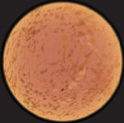
Mercury moves out of inferior conjunction and into the morning skies over the eastern horizon before sunrise during the last half of the month and remains visible until next month when Mercury moves to the opposite side of the Sun and superior conjunction. Late during August, Mercury will reappear in the evening skies at sunset.

Venus rises 2–3 hours before the Sun rises, and Venus is very visible over the southeastern horizon at sunrise. Venus also reaches its maximum apparent magnitude (greatest illuminated extent [GIE]) this month with a blazing—4.7. At that brightness you could see your shadow by standing on a white sidewalk or driveway but away from other light sources. Venus continues to dominate the morning skies, and during August Venus reaches its greatest western elongation of about 46 degrees. Venus also shares an interesting visual with the Moon this month. For a few mornings around the 13th, the Moon will be orbiting through the part of the morning sky where Venus is located. On those mornings, the phase appearance of the Moon and Venus will be strikingly similar—and for the same reason. Both go through phase change appearances as they orbit the Sun relative to the Earth and its orbit. We do not see a full Venus as it would be on the opposite side of the Sun from the Earth. However, when Venus is in the morning skies rising before the Sun, the phase appearance of Venus is a large and bright crescent, which over time goes from that to a smaller gibbous shape as it moves toward opposition (see Figure 3).
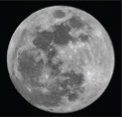
Luna, Earth’s Moon, will be at full phase on the 4th as it passes through the penumbra, the Earth’s dim outer shadow for a partial penumbral lunar eclipse. The full Moon will be visible across most of North and South America; however, the eclipse will go largely unnoticed because only about 35% of the Moon’s surface will be very slightly darkened during this partial penumbral lunar eclipse (see Resources).

Mars rises around midnight local time and is visible high over the southern horizon at sunrise. The “Red Planet” reaches perihelion, its closest to the Sun for this orbit, on August 3rd. The apparent magnitude of Mars nearly doubles during these two months as does its angular size. Opposition for Mars is during October, so the appearance of Mars will noticeably change.
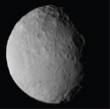
Dwarf Planet Ceres is located low over the southwestern horizon, but this month Ceres is too dim to be seen with the unaided eye during July and August.

Jupiter reaches opposition during July, and like the full Moon phase, Jupiter will be rising around sunset and setting around sunrise for the next few months. Keep an eye on Jupiter and Saturn to the east as the two will be closing in on a remarkably close conjunction during December.

Saturn will be at its own opposition relative to the Earth during July, and still close enough to that date during August to be visible all night as it rises around sunset and sets around sunrise.
Mars 2020 retrograde loop
All planets orbit the Sun toward the east as viewed from Earth. Any planet, or any other Sun orbiting object, further from the Sun than the Earth also orbits the Sun at a slower rate than the Earth. So, similar to a car passing one in the slower lane, the Earth passes by an outer object. From the perspective of the faster orbiting Earth, for a period ranging from several days to a few weeks or months, the outer object appears to be changing its orbital direction and to be moving backward or toward the west. This apparent backward motion is known as retrograde motion. The two inner planets, Mercury and Venus, also have a retrograde motion during approximately one-half of each orbit around the Sun. However, unlike objects further from the Sun than the Earth, the two inner planets actually do move toward the west as they orbit around the Sun, moving from eastern elongation to western elongation.
While the Martian retrograde event does not happen until after school has started, on September 9th the planet Mars will appear to have stopped in its eastward orbit. Then over the next several weeks Mars will appear to move backward from that stopping point. Mars is in retrograde motion, and while this apparent motion has nothing to do with the missions to Mars, it is an opportunity to focus attention on Mars during part of the month’s long cruise phase for Mars-bound spacecraft.
Bob Riddle (bob-riddle@currentsky.com) is a science educator in Lee’s Summit, Missouri. Visit his astronomy website at www.bobs-spaces.net.
Astronomy Earth & Space Science Middle School


